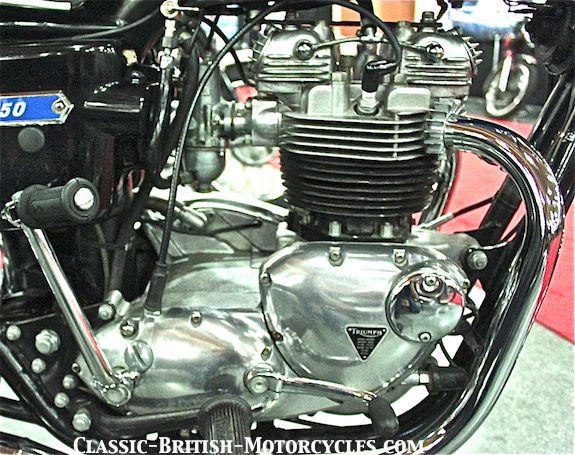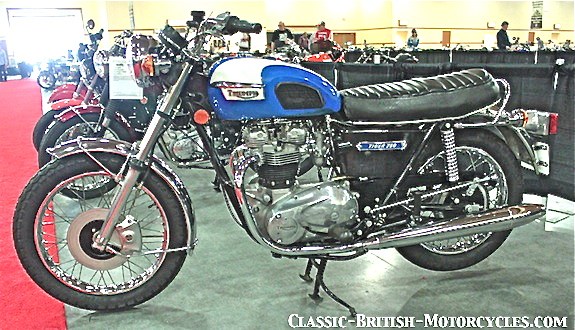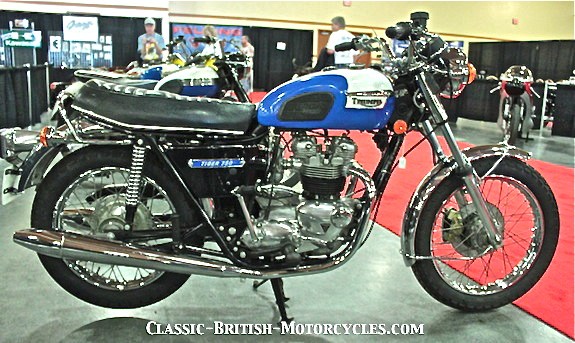1973 Triumph TR7
1973 TRIUMPH TR7 BY THE NUMBERS
1973 was the first year for the new 750 twins, in both the single-carb Triumph TR6 and Bonneville lines. When punched out to a 750 (724cc or 744cc), the 650 TR6 Tiger became the Triumph TR7; and the 650 (649cc) T120 Bonneville became the T140 Bonneville 750. Of course all were in the new oil-bearing frame & associated cycle gear. For 1973 only, the TR6 & TR7 were both offered for sale. By 1974, the TR6 had been eliminated from the lineup, leaving only the TR7 & T140, both 750s. There were 2 models of 1973 Triumph TR6: The TR6RV (a standard 650 Roadster with 5-speed gearbox) & the TR6P (Police). There were also 2 models of the 1973 Triumph TR7: The TR7RV (750 Roadster w/5-speed), and the TR7P (Police). Engine & frame numbers ran from JH15475 to GH35466, built from August 18, 1972 to June 15 1973. Paint colors were Astral Blue & Ice White with Gold pinstriping & the fenders (mudguards) were chromed.
ENGINE NUMBERS OF 650 vs. 750
JH15475 to JH15596 TR6RV 649cc
KH17097 to KH17121 TR6P 649cc
KH17122 to XH21715 TR7RV 724cc (75mm bore)
AH23727 to GH35387 TR7RV 744cc (76mm bore)
GH35388 to GH35466 TR7P 744cc (76mm bore)

1973 TRIUMPH TR7 ENGINE DISPLACEMENT GETS BUMPED…TWICE!!
As mentioned, the 650 Triumph TR6 continued on pretty much as is, engine-wise anyway (although it got the front disk brake of the TR7). Early TR7s were bored to 75mm (with the stroke left unchanged at 82mm) for a displacement of 724cc. However, a new cylinder block casting made it possible to bore them out to 76mm late in the model year for a displacement of 744cc & thus it would remain until the end of its life, in 1983. This new cylinder was actually one fin shorter than the original, which along with shorter conrods reduced engine height by about 1/2 inch, just enough to allow the engine to be shoe-horned into the frame on assembly. It was discovered immediately after the new oil-bearing frame in 1971 that the engine couldn’t be fitted in with the rocker boxes installed. Oops! Bad planning. This required new crankcases with a larger barrel mouth. The crankshaft was also lengthened to allow for the new triplex primary chain & the crank was treated to UNF threads at the same time.
1973 TRIUMPH TR7 – HOT CAMS
Some early 744cc engines were fitted with high performance E3134 cams because the correct ones weren’t on hand at the time (exact engine numbers aren’t available, but they may have started around #XH21257). If the cams themselves carry the part numbers E11063 (inlet) & E9889 (exhaust), & are fitted with 1-1/8″ radiused cam followers, then they are in fact 3134 cams. However, when the proper cams were fitted, the inlet followers were changed to 3/4″ radius, while the exhaust stayed with the 1-1/8″ tappets. The cam gears (pinions) now carried two sets of stamped timing marks, “A” & “B” (“A” aligned with the keyway on the exhaust cam & the dot on the idler gear; “B” aligned with the keyway on the intake (inlet) cam & the dot on the idler). Valve lash was now set at .008″ for the inlet & .006″ for the exhaust.

1973 TRIUMPH BONNEVILLE GETS A NEW TOP END
In addition to a new, shorter cylinder barrel, the 1973 Triumph TR7 came with a new cylinder head that now had 10 hold-down bolts instead of nine. A second 5/16″ bolt was added in the center, between the bores. A new headbolt setup included four 3/8″ studs screwed into the barrels, made of high-expansion steel. Sleeve nuts with internal threads & allen heads secured the head to the barrels. A new rocker box design was introduced from #CH27556 to accept the new head bolts. A larger 260 main jet was specified for the TR7s, while the TR6 remained unchanged.
1973 TRIUMPH TR7 – GEARBOX & PRIMARY CHANGES
The 5-speed layshaft was redeisnged with high gear being positively located laterally via a circlip which gave 4th gear constant end float. These can be easily identified by the two turned grooves on the layshaft spines. Heavy duty 1st, 2nd & 3rd layshaft gears & a much larger, stronger layshaft drive dog (marked with a Maltese cross) strengthened the tranny, along with a new layshaft gear gear selector fork. A new ‘low inertia’ shift cam plate replaced the fully round unit, allowing it to be removed without first having to remove the sprocket & high gear. The new triplex change & sprockets were fitted to both TR6 & TR7, with the TR7 getting a 20-tooth gearbox sprocket.

1973 TRIUMPH TR7 – FRAME & CYCLE GEAR CHANGES
The oil-bearing frame had started out in 1971 to tall in the seat. The rear subframe was modified in 1972 to bring it down to a reasonable 32.5 inches. The frame around the center stand brackets was strengthened. The oil sump was modified with a 3/8″ diameter oil feed pipe. UK models got rubber gaiters on the front forks. New chromed fork tops incorporated rubber-mounted headlight brackets, the left one carrying the ignition switch, to replace the fragile wire brackets of 1971-72. The forks were made slightly wider with new top & bottom triple clamps (yokes) to accommodate the new front disk brake. Internally, the front fork springs were shortened slightly to give less preload.
AT LAST…A DISK BRAKE!!
A mere 5 model years after Honda did it, Triumph finally replaced their aging front drum brakes with a proper hydraulic disk brake. The new 10-inch brake disk was clamped by a 2-piston Lockheed fixed hydraulic caliper on the left fork slider. The 7″ SLS conical rear brake remained unchanged.
1973 Triumph TR7 SPECIFICATIONS
|
T120RV Bonneville T140RV Bonneville Engine type Displacement, early Displacement, late Bore & Stroke, early Bore & Stroke, late Compression Carburetors Ignition Engine output Primary drive Primary sprockets Clutch Gearbox Ratios, overall: 1st, bottom 2nd 3rd 4th 5th, top Final drive Final drive sprockets Frame type Suspension, front Suspension, rear Brake, front Brake, rear Tire, front Tire, rear Fuel capacity Wheelbase Seat height Ground clearance Weight |
5-speed 650 Roadster 5-speed 750 Roadster Air-cooled OHV vertical twin 724cc / 43.0 ci 744cc / 45.0 ci 75mm X 82mm / 2.95″ X 3.23″ 76mm X 82mm / 2.993″ X 3.23″ 7.9:1 1- Amal Concentrics R930/89, 30mm Battery & coil, Lucas 47 bhp @ 6700 rpm 3/8″ triplex X 84 links Engine 29T X Clutch 58T Multi-plate, wet 5-speed constant-mesh, right-foot shift 12.25:1 8.63:1 6.58:1 5.59:1 4.7:1 5/5″ X .400″ X 3/8″ chain X 106 links Gearbox 19T X Rear 47T All-welded, oil-bearing large-tube backbone Telescopic fork, hydraulic damping 2-way Swing arm, 2 Girling dampers 10″ disk, 2-piston hydraulic caliper 7″ SLS drum, conical hub 3.25″ X 19″ Dunlop, ribbed 4.00″ X 18″ Dunlop, universal 3 Imp gal (US) / 4 Imp gal (UK & export) 54.5″ / 140.3 cm 32.5″ / 77.5 cm 5″ / 12.7 cm 395 lbs/ 179.3 kg |


